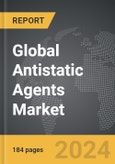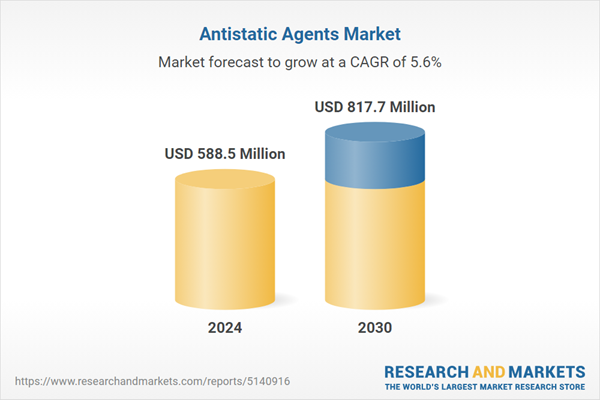The global market for Antistatic Agents was valued at US$588.5 Million in 2024 and is projected to reach US$817.7 Million by 2030, growing at a CAGR of 5.6% from 2024 to 2030. This comprehensive report provides an in-depth analysis of market trends, drivers, and forecasts, helping you make informed business decisions. The report includes the most recent global tariff developments and how they impact the Antistatic Agents market.
Segments: Product (Ethoxylated Fatty Acid Amines, Glycerol Monostearate, Diethanolamides, Other Products); Polymer Type (Polypropylene (PP), Polyethylene (PE), Polyvinyl Chloride (PVC), Acrylonitrile Butadiene Styrene (ABS), Other Polymer Types); End-Use (Packaging, Electronics, Automotive, Textiles, Other End-Uses).
Geographic Regions/Countries: World; United States; Canada; Japan; China; Europe (France; Germany; Italy; United Kingdom; Spain; Russia; and Rest of Europe); Asia-Pacific (Australia; India; South Korea; and Rest of Asia-Pacific); Latin America (Argentina; Brazil; Mexico; and Rest of Latin America); Middle East (Iran; Israel; Saudi Arabia; United Arab Emirates; and Rest of Middle East); and Africa.
The analysts continuously track trade developments worldwide, drawing insights from leading global economists and over 200 industry and policy institutions, including think tanks, trade organizations, and national economic advisory bodies. This intelligence is integrated into forecasting models to provide timely, data-driven analysis of emerging risks and opportunities.
Global Antistatic Agents Market - Key Trends and Drivers Summarized
What's Driving the Demand for Antistatic Agents?
Antistatic agents have become essential in a wide range of industries due to their ability to reduce or eliminate static electricity, which can cause significant problems in manufacturing and daily operations. The electronics industry, in particular, heavily relies on these agents to protect sensitive components from electrostatic discharge (ESD). As the consumer electronics market continues to expand with the proliferation of smartphones, tablets, and wearable devices, the demand for effective antistatic solutions has seen a corresponding rise. Additionally, the automotive industry's shift towards electric and hybrid vehicles has created a substantial need for antistatic agents to ensure the safety and reliability of electronic systems in these vehicles. The aerospace sector also benefits from these agents, using them to protect sensitive avionics and communication systems.How Are Innovations in Antistatic Technologies Shaping the Market?
Recent advancements in antistatic agent formulations have played a crucial role in shaping market dynamics. Innovations in nanotechnology and the development of new materials have led to the creation of more effective and longer-lasting antistatic solutions. These advancements have not only improved the performance of existing products but also opened up new applications in industries that previously did not utilize antistatic agents extensively. For instance, the textile industry has seen increased use of antistatic agents to enhance the safety and quality of fabrics used in high-performance clothing and industrial applications. Furthermore, the packaging industry has adopted advanced antistatic materials to protect electronic goods during shipping, reflecting a growing awareness of the importance of ESD protection in supply chain management.What Role Do Regulatory and Environmental Factors Play?
Regulatory pressures and environmental considerations are significant drivers in the antistatic agents market. Governments and regulatory bodies across the globe have implemented stringent safety standards to minimize the risks associated with static electricity, particularly in industries dealing with flammable and explosive materials. These regulations have compelled manufacturers to incorporate antistatic agents into their products and processes to comply with safety standards. Additionally, there is a growing trend towards sustainable and environmentally friendly antistatic solutions. Companies are increasingly investing in the development of bio-based antistatic agents that reduce environmental impact while maintaining high performance. This shift towards green chemistry is not only meeting regulatory requirements but also aligning with consumer demand for sustainable products.What Factors Are Driving Market Growth?
The growth in the antistatic agents market is driven by several factors. The increasing use of electronics in various industries, from consumer electronics to automotive and aerospace, has significantly boosted the demand for antistatic solutions. Technological advancements have led to the development of more effective antistatic agents, expanding their applications and enhancing their performance. The rise of e-commerce and the need for robust packaging solutions to protect electronic goods during transit have further propelled market demand. Additionally, the manufacturing sector's growth in emerging economies has created new opportunities for the adoption of antistatic agents. The heightened focus on workplace safety and regulatory compliance has also accelerated the integration of antistatic solutions in various industrial processes. Lastly, the trend towards sustainable and eco-friendly products has driven innovation in bio-based antistatic agents, broadening their market appeal and adoption across different sectors.Report Scope
The report analyzes the Antistatic Agents market, presented in terms of units. The analysis covers the key segments and geographic regions outlined below.Segments: Product (Ethoxylated Fatty Acid Amines, Glycerol Monostearate, Diethanolamides, Other Products); Polymer Type (Polypropylene (PP), Polyethylene (PE), Polyvinyl Chloride (PVC), Acrylonitrile Butadiene Styrene (ABS), Other Polymer Types); End-Use (Packaging, Electronics, Automotive, Textiles, Other End-Uses).
Geographic Regions/Countries: World; United States; Canada; Japan; China; Europe (France; Germany; Italy; United Kingdom; Spain; Russia; and Rest of Europe); Asia-Pacific (Australia; India; South Korea; and Rest of Asia-Pacific); Latin America (Argentina; Brazil; Mexico; and Rest of Latin America); Middle East (Iran; Israel; Saudi Arabia; United Arab Emirates; and Rest of Middle East); and Africa.
Key Insights:
- Market Growth: Understand the significant growth trajectory of the Ethoxylated Fatty Acid Amines segment, which is expected to reach US$390.3 Million by 2030 with a CAGR of a 6.1%. The Glycerol Monostearate segment is also set to grow at 5.4% CAGR over the analysis period.
- Regional Analysis: Gain insights into the U.S. market, valued at $152.3 Million in 2024, and China, forecasted to grow at an impressive 8.7% CAGR to reach $190.4 Million by 2030. Discover growth trends in other key regions, including Japan, Canada, Germany, and the Asia-Pacific.
Why You Should Buy This Report:
- Detailed Market Analysis: Access a thorough analysis of the Global Antistatic Agents Market, covering all major geographic regions and market segments.
- Competitive Insights: Get an overview of the competitive landscape, including the market presence of major players across different geographies.
- Future Trends and Drivers: Understand the key trends and drivers shaping the future of the Global Antistatic Agents Market.
- Actionable Insights: Benefit from actionable insights that can help you identify new revenue opportunities and make strategic business decisions.
Key Questions Answered:
- How is the Global Antistatic Agents Market expected to evolve by 2030?
- What are the main drivers and restraints affecting the market?
- Which market segments will grow the most over the forecast period?
- How will market shares for different regions and segments change by 2030?
- Who are the leading players in the market, and what are their prospects?
Report Features:
- Comprehensive Market Data: Independent analysis of annual sales and market forecasts in US$ Million from 2024 to 2030.
- In-Depth Regional Analysis: Detailed insights into key markets, including the U.S., China, Japan, Canada, Europe, Asia-Pacific, Latin America, Middle East, and Africa.
- Company Profiles: Coverage of players such as 3M Company, Akzo Nobel NV, Arkema Group, BASF SE, Clariant AG and more.
- Complimentary Updates: Receive free report updates for one year to keep you informed of the latest market developments.
Some of the 21 companies featured in this Antistatic Agents market report include:
- 3M Company
- Akzo Nobel NV
- Arkema Group
- BASF SE
- Clariant AG
- Croda International PLC
- Evonik Industries AG
- LyondellBasell Industries Holdings B.V
- Solvay SA
Tariff Impact Analysis: Key Insights for 2025
Global tariff negotiations across 180+ countries are reshaping supply chains, costs, and competitiveness. This report reflects the latest developments as of April 2025 and incorporates forward-looking insights into the market outlook.The analysts continuously track trade developments worldwide, drawing insights from leading global economists and over 200 industry and policy institutions, including think tanks, trade organizations, and national economic advisory bodies. This intelligence is integrated into forecasting models to provide timely, data-driven analysis of emerging risks and opportunities.
What’s Included in This Edition:
- Tariff-adjusted market forecasts by region and segment
- Analysis of cost and supply chain implications by sourcing and trade exposure
- Strategic insights into geographic shifts
Buyers receive a free July 2025 update with:
- Finalized tariff impacts and new trade agreement effects
- Updated projections reflecting global sourcing and cost shifts
- Expanded country-specific coverage across the industry
Table of Contents
I. METHODOLOGYII. EXECUTIVE SUMMARY2. FOCUS ON SELECT PLAYERSIII. MARKET ANALYSISCANADAITALYSPAINRUSSIAREST OF EUROPESOUTH KOREAREST OF ASIA-PACIFICARGENTINABRAZILMEXICOREST OF LATIN AMERICAIRANISRAELSAUDI ARABIAUNITED ARAB EMIRATESREST OF MIDDLE EASTIV. COMPETITION
1. MARKET OVERVIEW
3. MARKET TRENDS & DRIVERS
4. GLOBAL MARKET PERSPECTIVE
UNITED STATES
JAPAN
CHINA
EUROPE
FRANCE
GERMANY
UNITED KINGDOM
ASIA-PACIFIC
AUSTRALIA
INDIA
LATIN AMERICA
MIDDLE EAST
AFRICA
Companies Mentioned (Partial List)
A selection of companies mentioned in this report includes, but is not limited to:
- 3M Company
- Akzo Nobel NV
- Arkema Group
- BASF SE
- Clariant AG
- Croda International PLC
- Evonik Industries AG
- LyondellBasell Industries Holdings B.V
- Solvay SA
Table Information
| Report Attribute | Details |
|---|---|
| No. of Pages | 184 |
| Published | April 2025 |
| Forecast Period | 2024 - 2030 |
| Estimated Market Value ( USD | $ 588.5 Million |
| Forecasted Market Value ( USD | $ 817.7 Million |
| Compound Annual Growth Rate | 5.6% |
| Regions Covered | Global |









